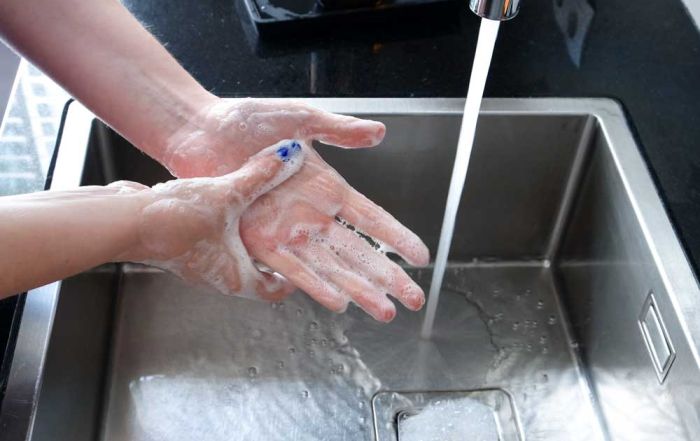Developing Good Food Safety Habits
Good habits and habit development are something that has fascinated me for several years. If you’ve attended any the training programs or presentations that my colleagues and I have conducted through our Center for Food Safety in Child Nutrition Programs, you’ve likely heard me opine about the importance of habits and how habits are created. Many times, in foodservice operations we wonder why our staff don’t follow the food safety practices we have established in our operation. Perhaps they don’t wash their hands when they are required, perhaps they just don’t use the proper method of handwashing, or perhaps we find that they don’t complete our HACCP logs as often as our program dictates should occur. And while we can stomp our feet and say “it is their job, they should just do it”, it really isn’t that simple. We can’t order people to change, although if we could, business and human resources would be so much simpler.
Habit often controls the actions we take in our work life. If an employee comes to you with bad habits related to handwashing, you must break those bad habits and reinforce positive habits.
When I visit with a food safety class, or any group about habits, I always ask the participants to think back to the time they were driving somewhere, for which they knew the route like the back of their hand and had driven it many, many times. Maybe it is the drive to your office, the drive to your parents’ house, or the house that you grew up in – whatever the case, I always follow up by asking how many of them had arrived at their location, only to not recall the last 5, 10, or 15 minutes of the drive because their mind was thinking of something else? Inevitably, close to 100% raise their hand. And that is habit. Habit is the part of our lives that takes over so we don’t have to think through the mundane activities that we undertake daily – getting ready in the morning, tying your shoes, combing your hair.
Applying habit to food safety is easy to do and perhaps you already have in the back of your mind. Habit often controls the actions we take in our work life, too. How well and when we wash our hands, cleaning of work surfaces before and after preparing an item, taking end-point cooking temperatures all have some function of habit associated with them. If an employee comes to you with bad habits related to handwashing, you must break those bad habits and reinforce positive habits. This is why some company leaders prefer to hire people who have never worked in the foodservice industry, rather than hiring those with experience. They are not forced to break bad habits of those employees before they can introduce them into the norms of their company culture.
In his book, The Power of Habit: Why We Do What We Do in Life and Business, Charles Duhigg discusses how habits are created and how we can go about changing them. The habit loop, as he calls it, includes three elements, the cue, a routine, and reword. Having a solid understanding of these will help you change your habits and the habits of your employees. I highly recommend adding this book to your must-read list for 2021.
There are many things to consider when working with and training employees in food safety. Indeed, there isn’t a magic bullet that will solve all our issues, but combined with other approaches, focusing on solid habit creation and change can be one more tool in your tool belt. Risk Nothing!
READ MORE POSTS
30 Years Later: The Foodborne Illness Outbreak that Changed Food Safety
In January, we hit a major anniversary. One I am betting snuck by many of you – including me! January marked 30 years since the deadly 1993 E. coli O157:H7 outbreak at Jack in the Box restaurants on the west coast. The anniversary wasn’t on any of the major news networks that I recall. It did make it into a few newspapers, at least one or two of the newspapers that are left. It wasn’t until late-February that I realized it.
Does Temperature Really Matter when Washing your Hands?
In January, I reviewed the changes to the 2022 Food Code in my blog (check out Part I and Part II), and one change to the food code that I had mentioned, but didn’t discuss in-depth, was the change that lowered the water temperature a hand sink was required to produce to 85°F, as noted in Section 2-202.12 of the code. This requirement has been in place since the publishing of the 2001 Food Code, which required a water temperature of 100°F. Prior to this, 110°F was required (see the 1999 Food Code). So why the change and does water temperature when washing your hands really matter?
Hand sinks: Often Taken for Granted, but an Essential Part to Effective Hand Hygiene
Late in January, I received a question about hand sinks in a foodservice operation. The question pertained to school staff (teachers and aides) who were using a hand washing sink in the school kitchen. The question came as a matter of who was allowed access to the kitchen to use the sink, but the question itself caused me to go down a rabbit hole of requirements for hand washing sinks in foodservice operations.
Hot off the Press: The 2022 Model Food Code has been Released! Part Two.
Earlier in the month, we started a discussion about the changes to the 2022 Food Code. If you missed that post, late in December 2022, the Food and Drug Administration released the 2022 Food Code and I wanted to highlight a few of the changes that have been made to the code.










